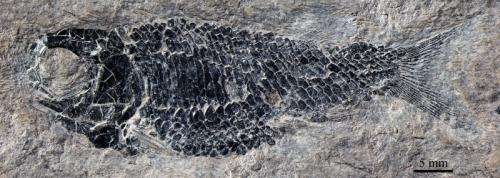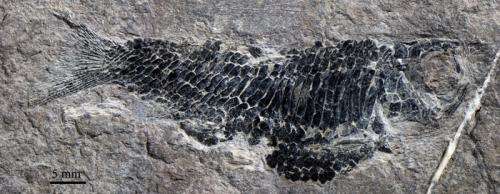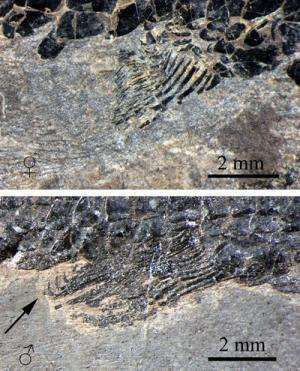Middle Triassic fossils reveal how flying fish started to glide

Modern flying fish are remarkable for leaping from the water to glide in the air using long, winglike fins, presumably to escape aquatic predators. This extraordinary gliding strategy, unlike those in terrestrial gliders, is energetically very expensive and has otherwise been hypothesized to occur only in a single stem group of the Neopterygii, the Thoracopteridae from the Late Triassic of Austria and Italy and Middle Triassic of South China. The evolutionary origin of the overwater gliding strategy was poorly known in the thoracopterids, since there is little in the way of missing-link fossils to illuminate how these fish evolved flight.
In a paper published online January 07 in the journal of Biology Letters (11), Dr. XU Guanghui, Institute of Vertebrate Paleontology and Paleoanthropology of Chinese Academy of Sciences (IVPP), and his collaborators from Zhejiang Museum of Natural History in Hangzhou, China, reported the discovery of a new thoracopterid fish on the basis of six well-preserved specimens from the Ladinian (235–242 million years ago) marine deposits of Xingyi in Guizhou Province, China. The new fish represents the most basal thoracopterid; although it seems that it was not a glider, its nearly complete skeletons provide us new and more comprehensive anatomical information of early thoracopterids. Phylogenetic studies suggested that the evolution of overwater gliding of thoracopterids was gradual in nature, i.e., a four-stage adaption following the 'cranial specialization–asymmetrical caudal fin–enlarged paired fins–scale reduction' sequence being recognized in thoracopterid evolution.
The new fish speciemens are recovered from the Middle Triassic Zhuganpo Member of Falang Formation at Wusha town of Xingyi County, Guizhou Province of China. The new fish, representing the most basal thoracopterid, was named Wushaichthys exquisitus, which means "exquisite fish from Wusha" in Greek and Latin. It was relatively small, measuring up to about 2 inches (5.2 centimeters) long. Researchers suggest it may have eaten plankton in the ocean's uppermost waters, and been prey for marine reptiles and larger carnivorous fishes.
Wushaichthys was distinguished from others of this family by a combination of features. "Our comparative studies resulted in a reinterpretation of the previously alleged 'peltopleurid' Peripeltopleurus as a primitive thoracopterid. Peripeltopleurus and the new fish from China share with the type genus Thoracopterus of this family the specialization of the skull pattern and scale cover, but both taxa retain many primitive characters unknown in Thoracopterus and other derived thoracopterids. Studies of these taxa provide new insights into the early evolution of the Thoracopteridae", said lead author Dr. XU Guanghui of the IVPP.

This newfound fish was probably not a glider. It lacked the bottom-heavy tail fin seen in all known subsequent thoracopterids that helped them generate the power needed to launch them out of the water. Wushaichthys also lacked the winglike fins seen in later thoracopterids that would have helped them glide. Moreover, Wushaichthys was fully covered in scales, unlike more advanced thoracopterids that lost their body scales, which presumably helped improve their gliding efficiency and maneuverability.
These new findings yield major insights on the evolution of flight in thoracopterids. Based on Wushaichthys and other thoracopterid fossils, Xu and his colleagues suggest the development of gliding in these fish was a gradual, four-step process. First, they evolved skulls that helped them live in surface waters. Next, they evolved tails that helped launch them from the water. Then, they evolved winglike fins that helped them glide. Finally, they lost body scales to make them more aerodynamic.

Addionally, Wushaichthys and Peripeltopleurus bear hooklets on the anal fin of supposed males, resembling those of modern viviparious teleosts. Researchers suggested that early thoracopterids probably had evolved a live-bearing reproductive strategy.
More information: "A Middle Triassic thoracopterid from China highlights the evolutionary origin of overwater gliding in early ray-finned fishes" DOI: 10.1098/rsbl.2014.0960 . Published 7 January 2015
Journal information: Biology Letters
Provided by Chinese Academy of Sciences




















